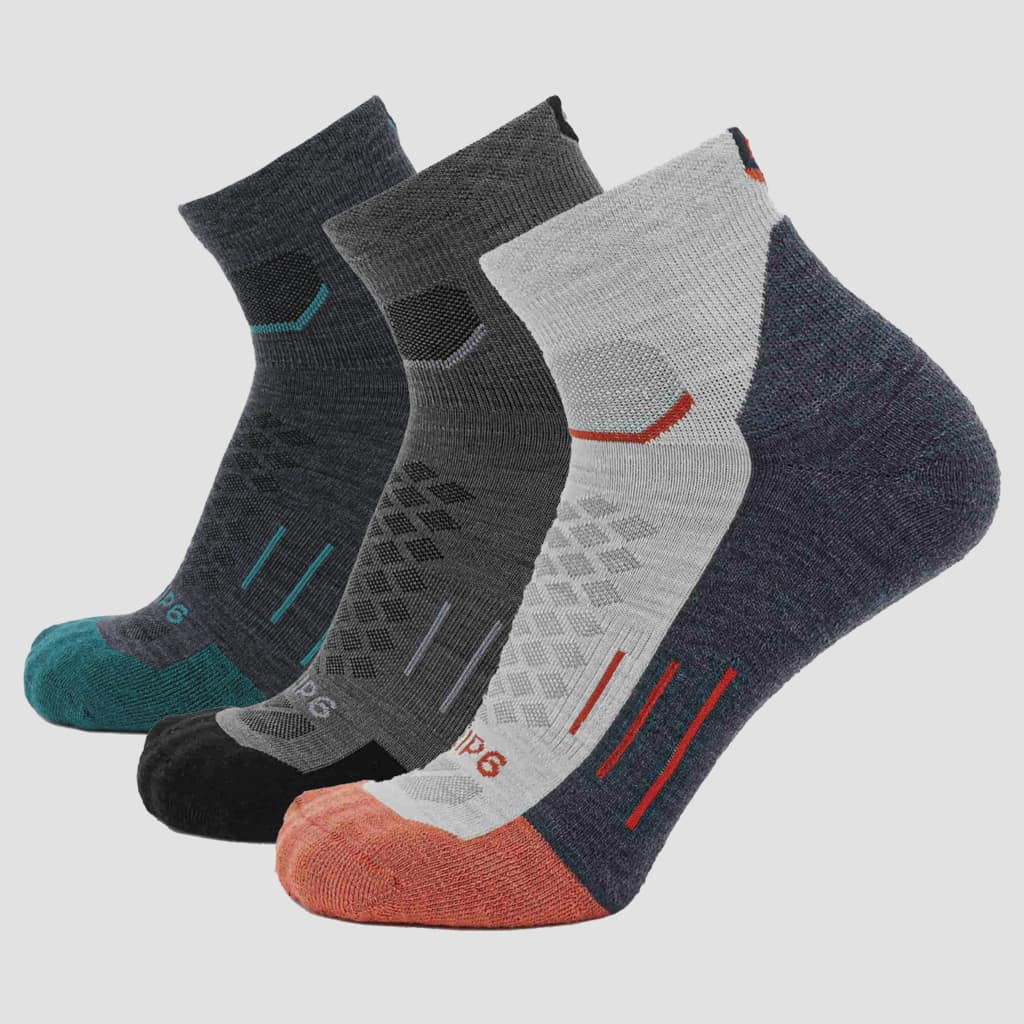What do sheep for rent, Franciscan missionaries, and Western wildfires have in common?
You may have seen on our social media posts or printed on the back of the sock packaging that we’re pretty excited about wool. So excited, in fact, that we pioneered a USA-based wool-testing lab.
We’re proud to be making steps to become a fully vertically integrated product company, and it’s critical for us to understand every step of the process. We wanted to illuminate one of the reasons why wool is our favorite material to work with: its effect on the environment.
Wool is a renewable resource that just happens to be a superior fiber to use in socks. But sheep are also fantastic creatures. Here in the Mountain West, we are frequently at risk of wildfires. And sheep are surprisingly good at mitigating this risk.
Read on to learn how. But let’s start with the history.
Increasing Wildfire Risk in the U.S.
Western snow packs are melting faster than ever before, which means summers are getting longer, temperatures are hotter, and vegetation is becoming tinder-dry. Hot air holds more moisture than cold air, so the hotter the air, the more grasses and shrubs are devoid of water.
2020 was a particularly bad year for fires--a combination of unusual lightning storms, human ignition, and the increasingly hot, dry environment--brought the issue to the forefront of the news. Something even more concerning is that California no longer considers there to be a fire season--because every time of year is the fire season now. And eight of the ten largest wildfires in California history have occurred in the last ten years.
Extremely dry forests and grasses have contributed to catastrophic fires in the West that have burned through massive swaths of land--10.2 million acres, to be exact. If good spring rains precede the dry period, the grasses often get so tall that they burn even more dramatically.

Image: A prescribed burn in Utah. Photo from KUER Utah.
The snowy peaks and sandy red rocks of Utah are not immune to wildfire dangers. Rising temperatures and increased tourism to Southern Utah has caused a considerable uptick in wildfires in recent years. As of May 2021, Utah is well above the five year average for the number of fires started, and the total number of acres burned.
Prescribed burning is a common strategy used to manage forests, grasslands, and other fire prone areas. The primary objective is to decrease the intensity of fires when they do happen by reducing fuel loads, creating fire breaks and thinning out overgrown timberlands. It’s true that wildfires can be a healthy part of the environment, and many fires occur naturally every year, but the rate and intensity of fires we’ve seen in the U.S. recently, is too much for the environment to handle.
So, where did all this grass come from in the first place?
The Origin of our Western Grasses
Not the west--but you maybe could have guessed that.
The United States is brimming with species brought here by traders and settlers from various European countries. From tomatoes to horses to ladybugs, many of the plants and animals we are used to seeing in the U.S. aren’t native to these lands. And that includes a vast majority of our grasses.

Image: Average summer temperatures have been increasing in California since 1900. Image from the LA Times.
Many western prairies are dominated by grasses introduced by Franciscan missionaries in the 1700s. Bricks in structures built by missionaries have been found with seeds that researchers previously thought weren’t introduced here until later on. The proof is in the structures: many of the grass species in the U.S. today were brought from Europe. Long story short, seeds of the Mediterranean Basin still greatly affect our world today.
Let’s look at the grasses of California, where wildfires ravish the landscape year after year. Within the state, less than 1% of grassland species are native. These grasses accumulate so much dry biomass that it becomes a significant fire danger. If these grases get too tall, they are more likely to catch fire and create the devastating burns the West has now become known for.
Within Utah, Idaho, and Nevada, non-native Cheatgrass and Medusahead Rye took over shrublands. These grasses are extremely flammable, especially if they get too long and dry.
Enter Sheep.
Sheep Aren’t Picky
First of all, sheep are one of the most adventurous eaters out there. Sheep eat weeds which cattle won’t, creating a more comprehensive, all-over grazing pattern. Sheep eat everything from young, tender plants to woodier twigs and shrubs.
Prescribed and controlled grazing are key ways in which ranchers can help reduce wildfire risk in the United States. By keeping the grass shorter, it won’t burn as intensely. And, with consistent, well-managed grazing, larger woody plants that are essentially lighter fluid for wildfires are stopped in their tracks.
Image: Acres burned in California in the last decade, with size comparisons to San Francisco and Yosemite. Image from the LA Times.
Companion grazing--adding sheep to graze alongside cattle--is an ideal way to manage grasslands because the sheep will eat the weeds that the cattle don’t. Another great thing about sheep is that they’re more agile than cows, so they can graze areas that cattle cannot. This is just another reason that they’re an ideal companion to cows--they venture where cows don’t.

Image: Sheep preparing to be sheared. Photo from GRIP6.
"Only Ewes Can Prevent Wildfires”
Researchers put sheep to the test in Carson City, Nevada. In the study titled “Only Ewes Can Prevent Wildfires,” a clever play off of Smokey the Bear’s tagline “Only You Can Prevent Wildfires,” sheep grazed a corridor around the city, which is highly susceptible to wildfires. In the end, the sheep removed roughly 71-83% of ignitable vegetation in the areas they grazed. A survey conducted after the study showed that 90% of homeowners supported the grazing practice and greatly preferred it over the chemical and mechanical methods of stopping and reducing fire spread.
Sheep and goats can get into hard-to-reach places that mowers cannot easily reach, such as gullies, canyons, and around other vegetation like trees. In California in 2019, there were actually not enough goats and sheep to go around! Ranchers had to turn down calls to have their flocks graze grassy areas--partly because of how effective they are at eating every piece of potential kindling in sight, but also because renting the flock is about a quarter as costly as having a human team come cut a fire line (a flock is $500 or more per acre).

Image: Wool from sheep sheared in the Mountain West. Photo from GRIP6.
According to research, targeted grazing should be used in conjunction with prescribed burns in order to achieve the best results. Here’s a state-by-state list of ranchers that provide goats and sheep for rental to graze fire-hazard areas.
What About Overgrazing?
Many people believe that mitigating fire risk through sheep grazing is more harmful than it’s worth because of the risk of overgrazing. The agriculture department of Utah put it best: “Well managed livestock grazing, though poorly understood by the average citizen, is the most effective way to manage vegetation on a large scale to benefit watershed health and preserve wildlife habitat.”

Image: A sheep being sheared. Photo from GRIP6.
Overgrazing is not about the number of animals on the land--it’s about how the animals are managed. A single animal can overgraze a field--yes, one. Skilled ranchers can manage large amounts of livestock and prevent them from overgrazing.
Light or moderate grazing has actually been shown to be more beneficial than no grazing at all because it mitigates fire risks and helps grassland species thrive. More on that below.
Making Room For Other Species
Keeping our grasslands grassy is a key component to letting grassland creatures thrive. While they may not be as publicized and well-loved as creatures of other environments, grassland animals need a home just like forest-dwellers, and others.
But it’s not only grazing that can greatly benefit American prairies. Trampling prevents trees and large shrubs from growing, which are major fire risks in the dry seasons. This also helps maintain the grassland itself and prevent it from developing into a forest, allowing grassland birds and other species such as the kit fox and ground squirrels to thrive.

Image: A flock of sheep from above. Photo from GRIP6.
Plants that require grassland environments to thrive also benefit from having grazing livestock around. For example, when livestock were removed from the habitat of the Sonoma spineflower in California, the population of the flower decreased at an alarming rate.
Finally, man-made ponds created for sheep support amphibians that have lost habitat from human development in other areas.
Next Steps
So, with sheep being a great animal for many reasons, where do we go from here?
First of all, we are going to continue full speed ahead with using wool as a primary sock material. We want to ensure that sheep still have a prominent place in the U.S. economy so they can continue being valuable for ranchers to raise.
Second of all, we are going to continue innovating at our wool testing lab here in Midvale, Utah. We want ranchers to have a domestic option to send their wool to, so they’re not shipping wool all the way across the world to be tested. Domestic manufacturing and American-sourced products are important to us, so we’re going to keep making steps to make our wool testing lab larger and more efficient than ever before!
Check out our socks and read more about the science behind Merino wool.







Leave a comment
All comments are moderated before being published.
This site is protected by hCaptcha and the hCaptcha Privacy Policy and Terms of Service apply.